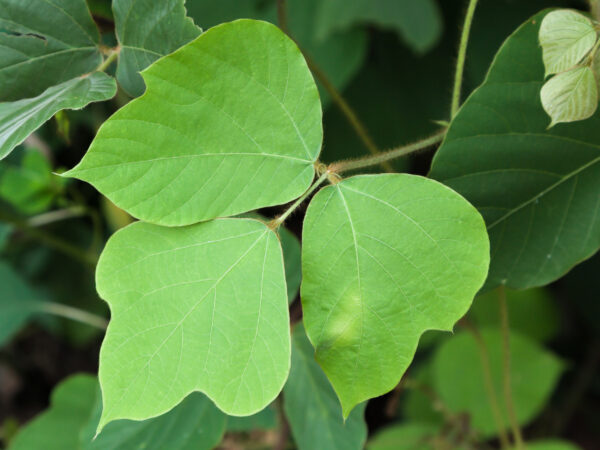
Kudzu (Pueraria montana)
Species at a Glance
Kudzu is a fast-growing creeping, climbing, and coiling perennial vine that is a member of the legume or pea family. It has the potential to reach up to 100 feet in length, allowing it to easily overtake trees, abandoned homes, cars, telephone poles, native plants, and essentially anything in its path. This species is considered one of the most aggressive vines introduced to North America.
Species Description
Kudzu leaves are large, ovate, and alternately arranged with three broad leaflets that are up to 10 cm (4 in) across and have hairs on the undersides. Each leaflet may be entire or have 2-3 deep lobes. Stems are typically 1-10 cm (0.5-4 in) in diameter, although there are reports of stems nearly 30 cm (12 in) across in Georgia. Kudzu possesses large, fleshy, tuberous roots, with massive tap roots that can be 18 cm (7 in) or more in diameter, 2 m (6 ft) or more in length and can weigh as much as 400 pounds. Flowers are approximately 1 cm (0.5 in) long, purple, highly fragrant and form long hanging clusters. Flowering occurs in late summer, followed by the production of brown, hairy, flattened seed pods that contain 3-10 seeds.
Native & Introduced Ranges
Native to Japan and southeast China, Kudzu was introduced into the United States in 1876 at the Centennial Exposition in Philadelphia, Pennsylvania where it was promoted as a forage crop and ornamental plant. Beginning in 1935, government agencies encouraged the planting of Kudzu to reduce soil erosion, and over 85 million seedlings were provided to landowners. It was removed from the list of approved plants for erosion control in 1953 and was designated a Noxious Weed in 1997. Since its introduction, Kudzu has spread to well over 3 million hectares of the eastern United States. In Pennsylvania, Kudzu can be found in much of the southeastern part of the state, as far west as Allegheny County, and as far north as Northumberland County.
Biology & Spread
Kudzu spreads rapidly and can quickly grow out of control. It spreads primarily through runners, rhizomes, and vines that root at the nodes of the plant. There can be as many as 30 vines growing from a single root crown. Once established, it has been reported to grow one foot per day, extending as much as 60 ft per season. It may also spread through seed production; however, there are only one to two viable seeds produced per pod. These seeds are contained within a hard seed coat that generally requires scarification for germination to occur.
Habitat
Kudzu is a structural parasite, relying upon the support of other plants to reach high light levels at the top of the forest canopy. While it can survive in a wide range of conditions and most soil types, it prefers forest edge areas, abandoned fields, roadsides, and disturbed areas where sunlight is abundant. Kudzu grows best where winters are mild, summer temperatures are above 27°C (80°F), and annual rainfall is 101 cm (40 in) or more.
Impacts
Threat to biodiversity
The aggressive, climbing nature of Kudzu enables it to overtake and grow over anything in its path, including native plants and trees. It smothers desirable vegetation under a solid blanket of leaves, blocking sunlight. Its stems encircle the stems and trunks of trees and shrubs, breaking their branches, and uprooting them through the sheer force of Kudzu’s weight. These impacts typically result in a monoculture of Kudzu and drastic reductions in native biodiversity.
Economic Costs
Economic losses from the impacts of Kudzu include lost income from forestry, control costs for utilities and agriculture, and control efforts in national and state parks. Lost productivity in forests has been estimated at anywhere between $100-500 million per year. Costs for power companies to control Kudzu have been estimated at $1.5 million per year, as it periodically interrupts power, especially in rural areas where it can topple power lines. Railroad companies are also impacted as Kudzu growth over rails can result in wheel slippage and derailments. National and state parks also devote considerable resources to controlling Kudzu as it can decrease the park’s historical and tourist value.
Prevention & Control
Since the 1950s, various control efforts have been directed towards limiting the spread of Kudzu and attempting to eradicate existing populations, including mechanical methods such as cutting, mowing, and grazing; herbicide treatments which are required for up to 10 years; and biocontrols such as bacterial blights, insect herbivory, and insect seed predation. For effective, long-term control, the extensive root system must be destroyed; otherwise, remaining root crowns can lead to re-infestation of an area.
References
Center for Aquatic and Invasive Plants. 2018. Pueraria montana. University of Florida, Institute of Food and Agricultural Sciences. Accessed from < https://plants.ifas.ufl.edu/plant-directory/pueraria-montana/>.
Forseth, I.N. and Innis, A.F. 2004. Kudzu (Pueraria montana): History, Physiology, and Ecology Combine to Make a Major Ecosystem Threat. Critial Reviews in Plant Sciences. 23 (5): 401-413.
Plant Conservation Alliance’s Alien Plant Working Group. 2005. Fact Sheets: Kudzu. Weeds Gone Wild: Alien Plant Invaders of Natural Areas. Accessed from < https://www.invasive.org/weedcd/pdfs/wgw/kudzu.pdf>.



